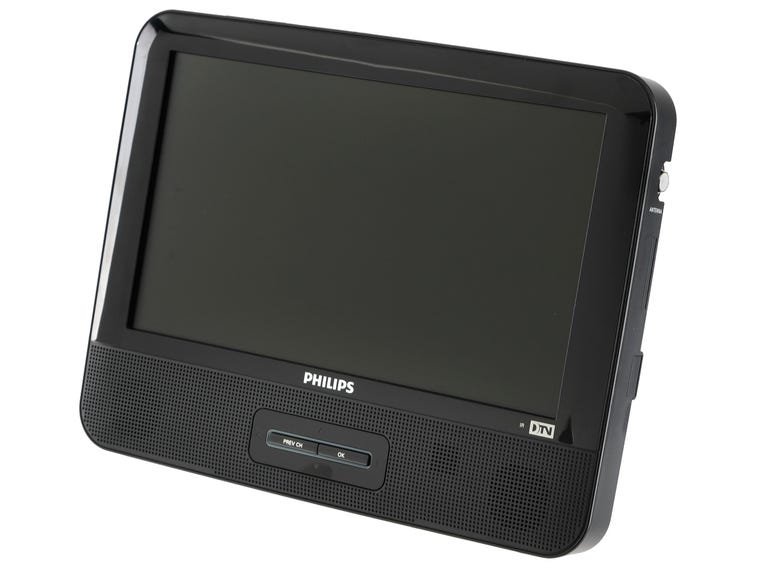 Why You Can Trust CNET
Why You Can Trust CNET Philips PVD900/37 review: Philips PVD900/37
Philips PVD900/37
Philips makes a few portable DTV models, including the 9-inch PVD900/37 reviewed here, as well as the step-down 7-inch PVD700/37 and PET729/37, which combines a portable DVD player with a 7-inch DTV.
The Good
The Bad
The Bottom Line
The PVD900, which online costs a little more than $150, looks and feels like your typical inexpensive tablet-style portable DVD player (sans DVD player). That doesn't mean it's ugly, it's just fairly basic and generic-looking, though at 9 inches diagonal, its screen is larger than some of the portable DTVs we've reviewed previously, like the Eviant T7 7-inch portable LCD TV and the Envizen Digital Duo Box Pro ED8850A. The TV is also surprisingly lightweight (1.5 pounds), so you can easily carry it. However, like all products that have shiny black finishes, the unit will attract its share of fingerprints if held in hand.
To prop up the TV for viewing, there's a kickstand on back that folds flush against the unit when not in use. To be clear, this is not a high-definition TV, but it can pull in high-def stations and display them on the TV's 600x220-pixel screen.
As for the DTV side of the equation, the PVD900 pulls in any TV signals being broadcast in your area, but you do have to attach a small, wired external antenna (its base is magnetized).
On the bright side, this model does have a built-in QAM tuner, so you can connect this to a cable TV outlet and receive basic unscrambled digital and HD stations via cable (so long as you have a cable TV signal coming into your house). We tried it out at home and had no trouble bringing in a wide variety of stations. However, on our cable system, the available channels were mostly the same we'd get via an antenna; don't expect to get CNBC, MSNBC, CNN, ESPN, or any so-called "premium" cable stations.
It's important to note two key caveats about the Philips PVD900. First, this model will not pull in any legacy analog or low-power stations that may still be broadcasting in your area--including analog over-the-air stations, analog cable channels, or those analog stations from Mexico or Canada available in border states. Secondly, this is a "portable DTV," but it does not use the newer Mobile DTV standard that is scheduled to be rolled out in 2010 and beyond. Mobile DTV products are designed to work while in motion (in a car or on a train). By contrast, this product--while easily transportable from room to room or on the go--is designed to be used only when stationary.
The downside to over-the-air digital TV is that if you can't get a strong enough signal, you don't get any picture for the channel you're trying to pull in (with analog signals, you could get a fuzzy picture). As part of the setup process, you can have the tuner automatically scan for channels and it will store them once they're recognized (you can easily autoscan if you enter a new area, though it does take a few minutes to run through the process).
We tried the TV in New York City and had decent luck pulling in stations so long as we were close to a window. Moving into an office just about 20 feet away from the window caused us to lose the signal for virtually all the channels, so your happiness with the product will depend on where you're located and whether you're able to get a strong signal.
When we were able to pull in a station, the picture was clear and reasonably sharp and the sound played ample volume through the two small speakers on the sides of the unit. We left the unit out in the middle of the office tuned into horror-show of daytime TV, and passersby were pretty impressed with the picture quality. However, as mentioned before, the screen resolution is only 600x220 pixels. That's standard for these types of inexpensive portable TVs and enough resolution to give you a reasonable picture, but the individual pixels are distinguishable at close range. We're looking forward to the day when manufacturers can deliver higher-resolution displays at this size for about the same price.
As for battery life, this model offers just under 3 hours with the brightness setting on the LCD set at the next to lowest level. That's better than some we've tested, but you'll be lucky to catch a full baseball or football game within that window. We should also point out that the rechargeable battery doesn't appear to be removable, so you can't buy an extra one to tote around with you for extra juice.
It would have been nice if the PVD900 had some sort of connectivity option that would allow you to display video from an iPod or iPhone (or any video capable device), but alas there are no inputs or outputs other than a headphone jack. (Also annoying: there are clearly spots on the side for USB and SD card slots, but Philips chose not to include that functionality with this model.) We also thought it was too bad you couldn't turn off the TV using the included remote. Instead, you have to manually turn the TV on and off using the switch on the switch of the unit. On top of that, while you can mute the TV using the remote, you can't adjust volume levels (the volume control is on the side of the unit). That's a shame.
At the end of the day, this Philips' strengths are the size of its screen, better than average battery life, and the inclusion of a QAM tuner. We have no problem recommending it, but you should be warned not to expect too much.


